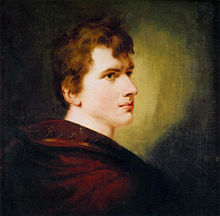Strange encounters and reunions
Strange encounters and reunions is a story by Achim von Arnim , which, written around 1816, was published in 1818 in Maurer's bookstore in Berlin as part of the “Die Sängerfahrt” collection (publisher: Friedrich Förster ).
The fiancée, that is Julie and the French captain Stauffen, who is staying with her, cannot find each other.
content
The beloved old father, the Colonel, fell on the day of the great battle and Julie was now alone. The young girl becomes engaged to Rittmeister Stauffen and encounters resistance from her best friend Constanze, a French hater. Julie does not want her step to be denigrated as "dishonor" by the patriotic Constanze. The Rittmeister is a native German who lost his parents in the turmoil of the revolution . The disaster takes its course. Julie recognizes a bracelet as the property of her blessed father. The jewelry is in the possession of the Rittmeister's groom. The lad had taken the jewelry from a dead enemy. It turns out that Stauffen killed the future father-in-law in battle. Julie breaks up with the killer. The Rittmeister is posted from Germany to Madrid in the Napoleonic General Staff there. Constanze intercepts a letter he writes to Julie from Spain. The couple who are still in love are disappointed. Stauffen would have expected a few lines of reply for his letter. Julie is offended because the fiancé left without saying goodbye. Constanze takes her friend to see her foster father, her uncle. On the way, Julie seeks her father's final resting place near the battlefield.
In Spain the Rittmeister receives "the death sentence of his love" - a letter in reply, written by Constanze himself. Stauffen - amazed - recognizes his father's handwriting in the letter. Promoted to colonel after four years of service, Stauffen is recalled from Spain. On the trip to see Julie - while still in Spain - he happened to meet his mother Klara in a monastery. The mother believes Freiherr Constantin, Stauffen's father, dead. The marriage had remained secret.
When Stauffen set foot on German soil on his onward journey, the French army had long since perished in Russia . German volunteers rush to arms. The rider Stauffen, already near the beloved Julie, is surrounded. He fights with the saber until both arms are severed. Defenseless as a child, the seriously wounded man is taken prisoner. Julie is still staying on the estate of Constanze's foster father, where she and Constanze take care of the numerous war victims who have gathered. The couple meets. Stauffen recognizes the lover, but when his gaze is not returned, he turns away. The sight of the beloved wounded man had touched Julie's heart, but a punishing look from Constanze had put Julie in her place. On a walk the uncle recognizes Stauffen, who is lying on the road, as the son of his secret love. The Baron Constantin kisses the dead.
After her uncle's death, Julie inherits his property and visits Stauffen's mother, Klara. The two women use the money to rebuild the Spanish monastery that was destroyed by the war.
reception
- In June 1818, FG Wetzel praised the "exemplary clarity and vividness of the presentation" in the Jenaische Allgemeine Literatur-Zeitung .
- Unfortunately, the couple found themselves too late after Andermatt. Then, separated for years by the war, Julie and Stauffen become estranged. The story ends without a reconciliation between the two. Worse still, love ends on the country road. Stauffen, who died, is simply left behind.
- Julie was responsible for the death of her lover because she was unable to rise above the nationalism of Constanze while on probation.
- Stauffen did not become a soldier for reasons of conviction, but because he saw no other career path without a father. Thus the colonel stands for a stunted Germany.
- Andermatt refers to further leading works: Gerhard Möllers (Diss. Münster / Westphalia 1971, pp. 117-139), Bruce Duncan (Fate and Coincidence in Arnim's Seltsames Treffen und Wiedersehen , 1979) and Christof Wingertszahn (Saarbrücker Contributions to Literary Studies, Vol. 23, 1990).
- According to Wingertszahn, Arnim splits the female psyche - from a purely psychological point of view - as it were into the woman Julie and the Amazon Constanze.
literature
- Helene M. Kastinger Riley : Achim von Arnim . rowohlt's monographs edited by Kurt Kusenberg . 158 pages. Reinbek near Hamburg in July 1979, ISBN 3-499-50277-1
- Renate Moering (Ed.): Achim von Arnim. All the stories 1802–1817. Vol. 3, pp. 1358-1364 in: Roswitha Burwick (Ed.), Jürgen Knaack (Ed.), Paul Michael Lützeler (Ed.), Renate Moering (Ed.), Ulfert Ricklefs (Ed.), Hermann F. Weiss (ed.): Achim von Arnim. Works in six volumes. 1398 pages. Deutscher Klassiker Verlag Frankfurt am Main 1990 (1st edition), ISBN 3-618-60030-5
- Michael Andermatt: Stunted life, happiness and apotheosis. The order of the motifs in Achim von Arnim's narrative. 629 pages. Peter Lang, Bern 1996, ISBN 3-906756-15-7
Quoted text edition
- Achim von Arnim: Strange encounters and reunions . P. 319–363 in Konrad Kratzsch (Ed.): Achim von Arnim: Erzählungen. 635 pages. Aufbau-Verlag Berlin and Weimar 1968 (1st edition)
Web links
- The text at Gutenberg-DE
Individual evidence
Source means the quoted text edition
- ^ Andermatt, p. 159, 9. Zvo
- ↑ quoted in Moering and Riley, p. 136, entry anno 1818
- ↑ Source p. 626, entry 320: October 14, 1806 - Battle of Jena and Auerstedt
- ↑ quoted in Moering
- ↑ Andermatt, pp. 168, 253
- ↑ Meant is the last (eponymous) reunion of the couple on the uncle's estate.
- ^ Kratzsch in the afterword of the source, p. 613, 8th Zvu
- ^ Andermatt, pp. 352, 361
- ↑ Andermatt, p. 168, 5. Zvo
- ^ Wingertszahn cited in Andermatt, p. 204, footnote 39
